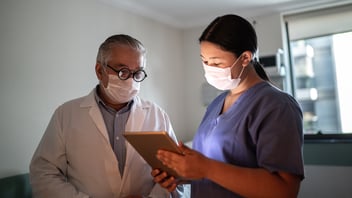Secure texting for healthcare: The basics

What is secure text messaging?
A secure text messaging platform employs smartphone apps to connect authorized care team members to a HIPAA-compliant network. It enables care teams to coordinate schedules for quick access to on-call clinicians, share PHI and other data, and collaborate efficiently.
What are the benefits of secure text messaging?
The rapid flow of vital information through secure text messaging has been shown to improve overall patient care. “Secure messaging in healthcare accelerates clinical workflows,” states the HIPAA Journal. “It has been shown to help accelerate patient throughput, reduce the potential for medical errors, increase patient satisfaction, improve clinical outcomes, and significantly reduce costs while ensuring compliance with HIPAA.”
Why replace pagers with secure text messaging?
Pagers are a legacy technology with high costs and baked-in security and communication issues. Pager messages are frequently not HIPAA compliant. Pagers are subject to poor communication and delays, because they do not provide the sender’s identity, urgency level, and patient context – or a way to respond directly to the sender.
A study by the Ponemon Institute showed that hours lost due to inefficient communication by pagers cost a typical healthcare organization an average of $557,000 per year.
What’s the difference between basic and advanced messaging platforms?
Basic texting platforms are designed for general business use. They can fall short when handling the complexity and urgency of today’s healthcare.
For example, for care teams that use basic texting, every message and every reply is sent to all members. Team members often get alerts for low-priority texts, resulting in alert fatigue and clinician burnout. An advanced messaging platform automatically prioritizes alerts to minimize alert fatigue.
Basic texting is not designed for clinical collaboration. An advanced messaging platform enables care teams to securely collaborate in real time on their own smart phones, speeding patient throughput and reducing errors.
Advanced messaging platforms integrate on-call scheduling for efficient communication, and provide telehealth services both with patients and between clinicians.
Do advanced messaging platforms integrate with EMRs?
Advanced platforms integrate with EHRs, call center and on-call systems, and facilitate connections with partner organizations.
What is telehealth?
Telehealth technology delivers healthcare remotely to the patient. It enables clinicians to easily communicate with patients remotely by text, voice, or video. Clinicians can host HIPAA-secure video appointments using the smartphones they already own.
In addition, telehealth can refer to clinician-to-clinician video communication, such as remote consults.
The future of advanced messaging platforms
A study by Black Book Market Research found that ninety-six percent of hospitals are budgeting for or investing in advanced messaging platforms. “Stakeholders across the healthcare industry are searching for solutions that utilize comprehensive real-time data and connectivity to advance patient safety, productivity and profitability,” said Doug Brown, president of Black Book Market Research.
About Backline
Designed by actual clinicians, Backline is a healthcare-specific platform that helps manage the complexity and urgency of today’s clinical environment. In addition to providing secure communications and telehealth, we deliver a virtual workspace that brings providers together to collaborate across units and disciplines. Health systems that use Backline elevate their efficiency, while increasing clinician and patient satisfaction.



